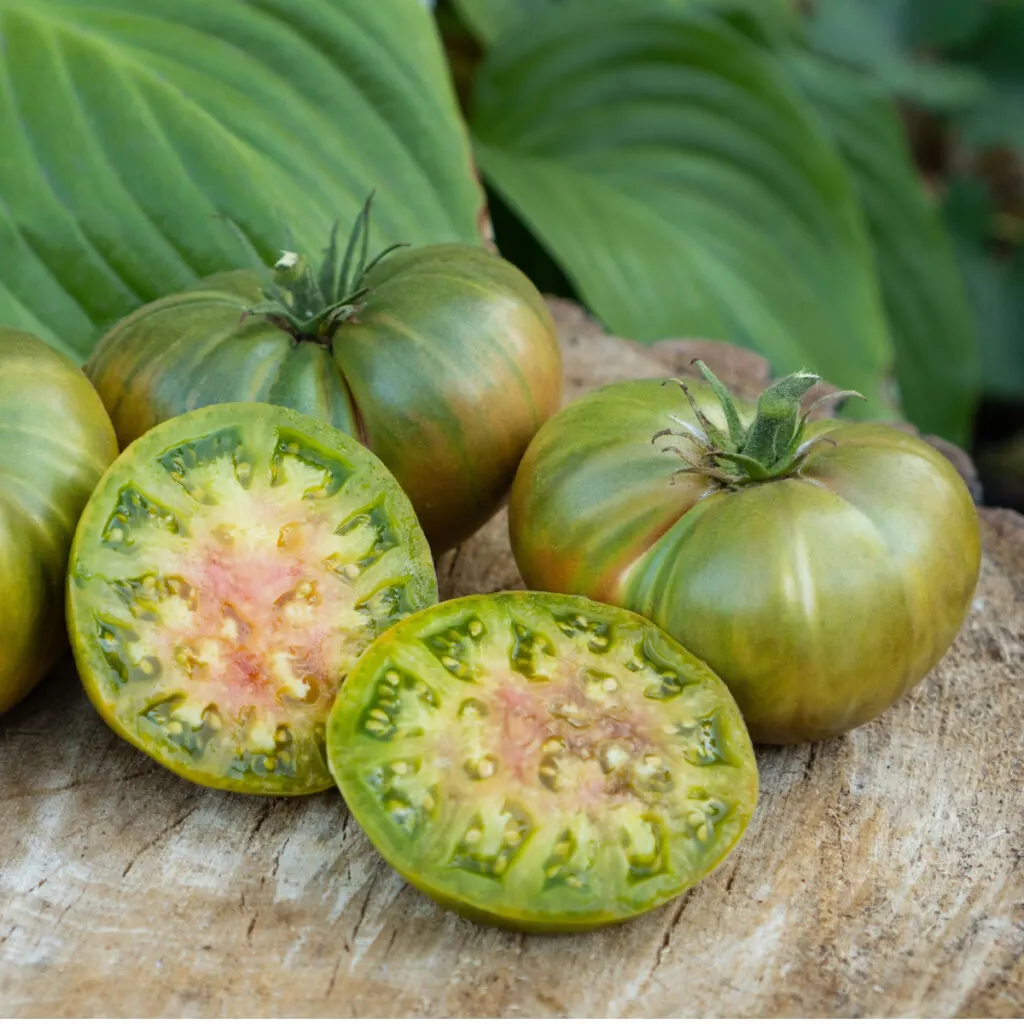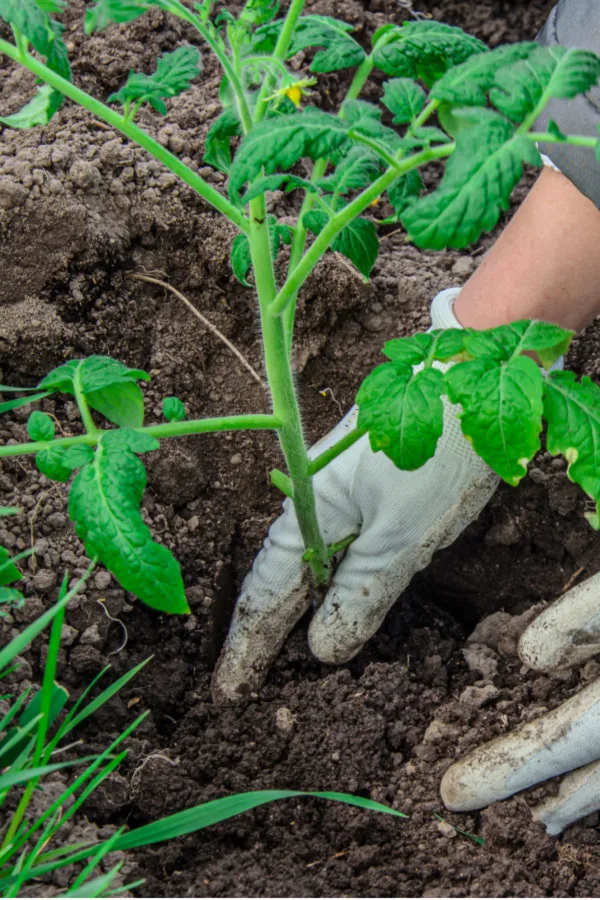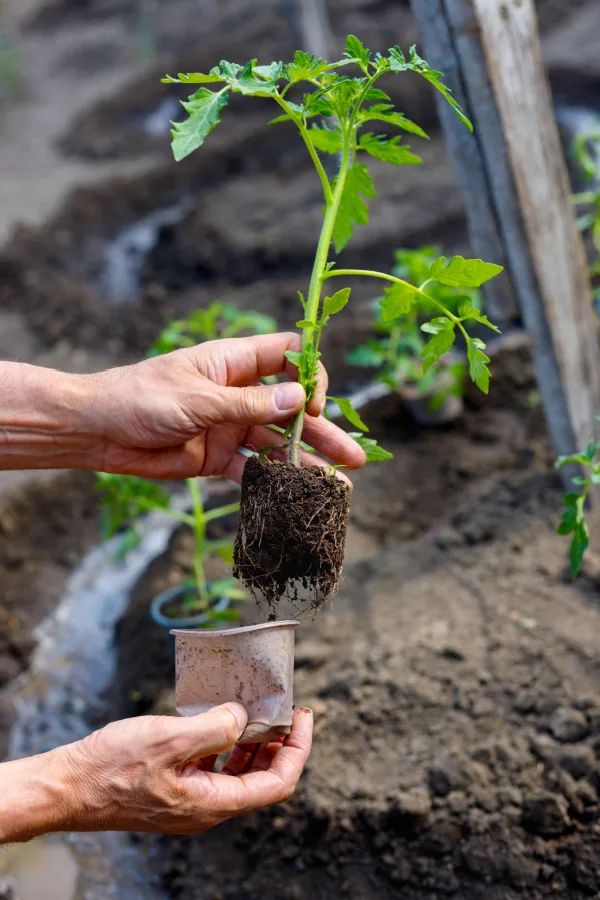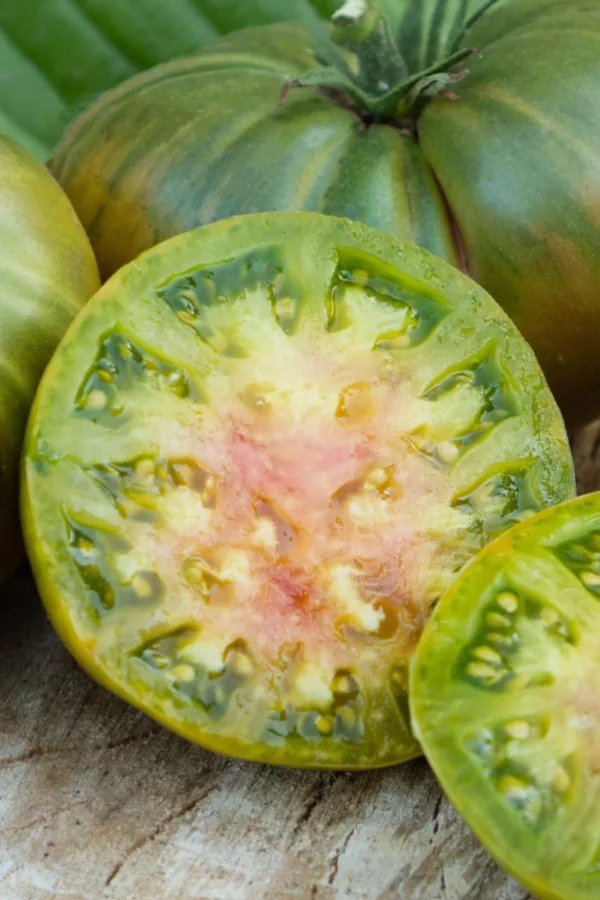If you are looking to add bold, amazing flavor and a uniquely ripe green tomato to your garden, then growing the Aunt Ruby’s German Green tomato variety in your garden is a must!
Aunt Ruby’s beefsteak tomatoes have a bold, lime green color with a meaty interior. The firm yet juicy tomato is filled with a great balance of flavor – with strong notes that are both sweet and acidic. And even better, these delicious tomatoes are perfect for slicing, pickling, or even frying up in a pan!
One thing is for sure, once you grow and taste this amazing heirloom variety, it will quickly become a favorite to grow and harvest year after year!

As an indeterminate, the plants produce a fair number of tomatoes all throughout the growing season, from mid-summer right all the way up to the first frost. And they can grow some seriously large fruits. In fact, Aunt Ruby plants can produce tomatoes that can top a pound or more per tomato!
The Origin Of Aunt Ruby’s German Green Tomatoes
So where did Aunt Ruby’s tomato come from? It is thought that this unique, green ripening tomato originated in Europe – specifically, from a woman by the name of Ruby Arnold who grew them in her home country of Germany.
Like many Europeans at the time, she and her family later immigrated from Europe to the United States. As the lore goes, she then started growing the large green tomatoes in her new home of Tennessee.
Of course, the locals loved the flavor and taste as well – and the tomato’s popularity grew. And as it did, in honor of the woman that brought it here, the variety began to be called Aunt Ruby’s German Green Tomato!
Growing Aunt Ruby’s German Green Tomatoes
Aunt Ruby’s grow big and have extensive root systems, because of that, they are far better to be grown in a traditional garden or large raised bed setting than in containers. While large containers are possible, they will not produce as large of tomatoes or harvest due to smaller roots.

The best location for planting Aunt Ruby’s German green tomatoes is in a sunny space that receives at least six to eight hours of sunlight each day. Equally as important, these heavy feeders need a nutrient rich soil that drains well.
Starting From Seed
Because of their uniqueness, Aunt Ruby tomato plants are often hard to find locally. Most gardeners who grow them start their own plants directly from seed. The good news? As an heirloom tomato, after purchasing once, you can save your own seed stock from year to year to always have access to seeds. Affiliate Seed Link: Aunt Ruby’s German Green Tomato Seeds
The plant takes nearly 80 days from seed to harvest, so having healthy strong transplants early is important. When starting from seed, it is best to start seeds a full 8 weeks before you intend to plant outdoors. This will give them a good head start when they go in the ground.
As with all tomato plants, begin to harden off plants a few weeks before planting day. This will allow the transplants plenty of time to acclimate to growing outdoors.
Transplanting – Growing Aunt Ruby’s German Green Tomato
While still indoors, you can transplant your strongest plants into larger pots once they’ve reached 8 or more inches in height. Be sure to use a rich mixture of potting indoors for continued growth. Organic additives such as worm castings, coffee grounds and ground egg shells are excellent to add to the soil to power the plants early growth.

Once there is no more threat of frost and your plants are leafy and strong, it’s time to plant them outdoors. For Aunt Ruby tomato plants, spacing is important. Because they grow big, space plants at least 3 feet apart. This will allow plenty of room for growth and for light to get to the plants.
When planting, plant deep. Aunt Ruby’s grow large and tall and need a good root system to support the plants up top. Planting deep allows extra roots to develop in the soil, ensuring a strong root system that will give the tomatoes a strong foundation for successful production.
Because of the potentially large fruit size, it’s best to add a cage, stake or trellis at planting time. Doing so later risks damaging the plants root system. In addition, early support of the plant’s limbs and branches can keep the plant from toppling over.
Supporting your tomato plants also allows better for better airflow and sun exposure. Within approximately 80-95 days, you should notice hefty green fruits ready for harvest.
Plant Maintenance – Growing Aunt Ruby’s Green Tomatoes
For good production, Aunt Ruby’s tomato plants need around 1 to 1.5 inches of rain or water per week. Mulching plants will help to conserve moisture in the soil but if dry conditions occur, watering plants is a must.

In addition, as a heavy feeder, fertilizing is a must as well. Supply your tomato plants with a boost of liquid fertilizer every two to three weeks for optimum growth.
As with all tomato plants, when fertilizing use a liquid fertilizer with a higher phosphorous and potassium makeup. Although nitrogen is important for strong growth, phosphorous and potassium are the key nutrients to help produce more fruit.
This plant grows very large so pruning is usually necessary in order to keep it under control. Prune underneath the plant to allow for twelve to eighteen inches of air flow at the bottom. Top and side branches can be pruned as necessary to keep the limbs supported.
Harvesting Aunt Ruby’s German Green Tomatoes
It’s usually fairly easy to determine the best time to harvest traditional varieties of red, yellow, orange and purple tomatoes. Once they’ve gone from an unripe green to their specific color, it’s time for picking. But with Aunt Ruby’s green tomatoes, since they are green when ripe, that isn’t the case.
A ripe green tomato will be slightly softened and have a little give when gently squeezed. Specifically with Aunt Ruby’s German green tomatoes, you should notice a slight blush color starting to form at the bottom.

Also, you may even see a bit of a star shape appear just under the base. This can signal that the tomato is ready to harvest and enjoy. Of course, a large hefty fruit is a good sign it’s ready as well.
As far as flavor, the taste should not be bitter in the least. You should notice an acidic, sweet and almost fruity flavor. These homegrown heirlooms should be rich, sweet and tangy with a meaty texture.
Enjoying Aunt Ruby’s Green Tomatoes…
As mentioned earlier, Aunt Ruby’s German green tomatoes are best when enjoyed fresh. From simple juicy, meaty slices with a pinch of salt, to a classic BLT sandwich, you can’t go wrong.
They can also be preserved when pickled or canned and even fried and enjoyed as a classic southern specialty! Be sure to check out our Tomato Varieties Tab on the website for even more great tomatoes to grow in your garden!
Follow Our Facebook Page For Even More Great Tomato Growing Tips! I Grow Tomatoes Facebook Page
I Grow Tomatoes is a website created for those who love all things about tomatoes – from planting and growing – to cooking and canning! We publish two articles every week, 52 weeks a year. Sign up today to follow via email! This article may contain affiliate links.
